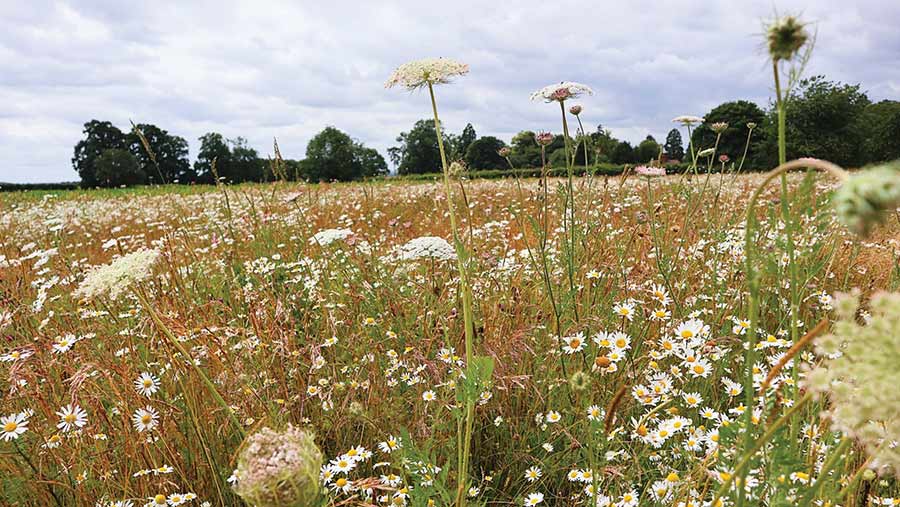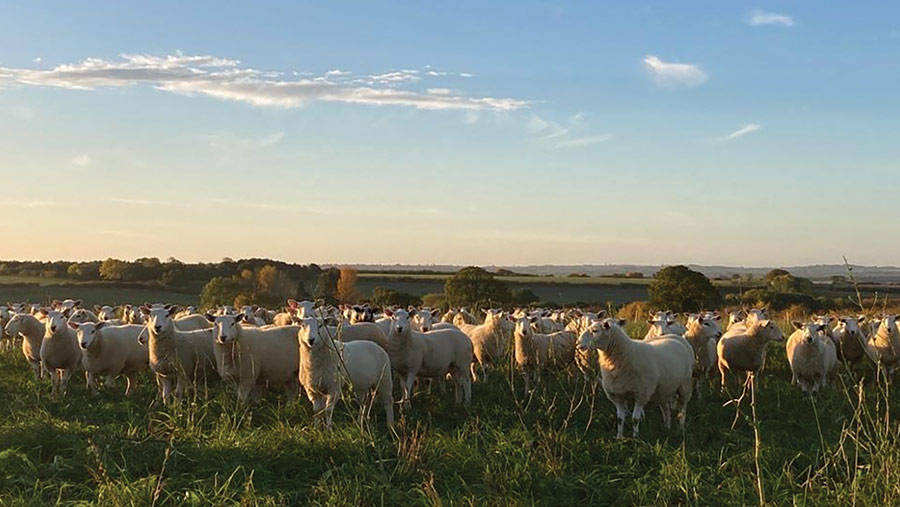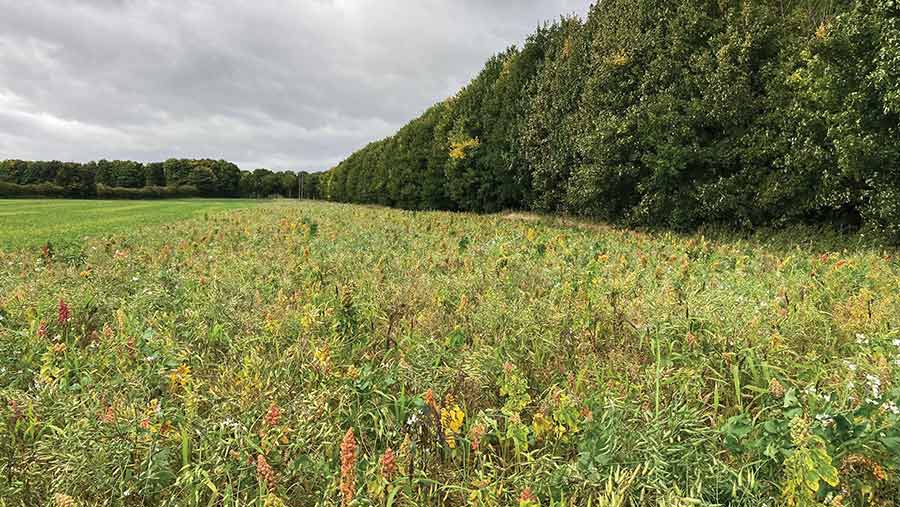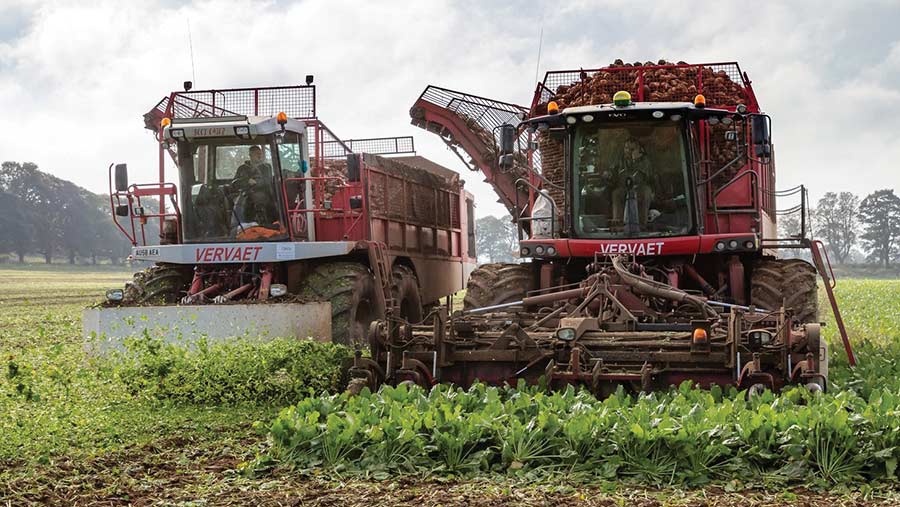How an arable estate gets the best out of stewardship schemes
 © Buckminster Farms
© Buckminster Farms Agri-environment schemes have already provided resilience and risk management at Buckminster Farms, a large-scale farming business on the Leicestershire/Lincolnshire border.
The challenge ahead is to integrate elements of the Sustainable Farming Incentive (SFI) to complement and enhance what has already been done, acknowledges farm manager Matthew Wallace, who is not rushing into any decisions that he may later regret.
See also: Which SFI actions can help optimise fertiliser use?
An extensive mid-tier countryside stewardship agreement, which started two years ago, resulted in several changes to the business – with traditional break crop areas reducing, a sheep enterprise being introduced and just over 20% of the farm area being taken out of production.
At the same time, new spring crops in the form of sugar beet and maize were introduced on suitable land.
Both were higher value break crops than existing choices, with guaranteed markets, and allowed cover crops to be grown ahead of them to support soil function.
The opportunity to further improve soil health and weather-proof the farm’s predominantly heavy clay soils was also seized, with legume fallows and herbal leys coming into the rotation and a “sustainable extensification” approach being adopted.
Financial implications
“I looked at the financial implications of the farm’s less productive areas, using yield maps and margin analysis,” reports Matthew.
“It became very obvious where we should be considering stewardship instead of cropping and how whole field options could be used to help with blackgrass control.”
He worked with Richard Barnes, head of sustainable crop production at Frontier Agriculture, to finalise the scheme and be certain of success, as well as maximising the income that could be generated.
“With some careful planning, it’s possible to implement a scheme that involves a flow of options, that work for both the farm and the environment,” says Richard.
“A good example is using grazed cover crops before a low input spring cereal option.
“The income streams are environment, lamb and cereals, while input use is reduced and soils are improved, with the rotational benefits of blackgrass control.”

© Buckminster Farms
Wider issues
The scheme also addresses the wider concerns that affect most farms – climate change, biodiversity collapse and market volatility, he notes, helping it to prepare for a less certain future.
The Buckminster Farms agreement which started in January 2022 includes:
- AB15: Two-year legume fallow
- GS4: Herbal leys
- SW6: Winter cover crops
- AB14: Low-input spring cereal
- AB9: Winter bird food
- Hedgerow management options.
Lessons have been learned, admits Matthew. “We’ve had things that have worked very well and others which have not gone so well.”
AB15 is used as a whole-field option where blackgrass levels are very high and in 12m and 24m strips on headlands, as well as to square fields up.
“We’ve found that it’s not a blackgrass control tool,” he reports. “The difficulties we had with it are establishing legumes in the autumn and recognising how much topping is required to prevent seed return.
“In the right places, it’s a good rotational tool which allows for some fertility building.”
Rotational changes
Herbal leys in the form of GS4 were established, allowing an outdoor forage-based sheep enterprise to be started.
The sheep are also used to manage the cover crops on the farm, reducing the total biomass and letting light through to the soil surface to aid drilling in the spring.
“This approach also moves fertility around the farm. Once the sheep are taken off, the covers get an application of glyphosate after greening up, but before the following spring crop is drilled.”
Capital grants have helped with the costs of fencing and sheep handling equipment.
Matthew is convinced that grazing is a better way of controlling blackgrass, but admits that they haven’t taken GS4 out and into winter wheat yet.
“The quality of forage from GS4 is variable, but it is very productive. Our sheep have done very well on it, gaining more than 500g/head a day in most cases.”
Multi-species winter cover crops as SW6 were put in ahead of spring cropping, allowing the sheep enterprise to be integrated and, in some cases, spring oats to be grown as a low input spring cereal.
“Whatever spring crop is following, we graze the covers off carefully to minimise soil damage,” says Matthew. “The sheep are an additional tool to herbicides when it comes to grassweeds.”
Another lesson learned is that he made some stewardship areas too small. “I would be bolder with options such as AB9 – having little plots of it everywhere adds to the management burden.”
What’s next?

© Buckminster Farms
A big Mid Tier agreement means the Sustainable Farming Incentive will be introduced initially on a smaller scale, says farm manager Matthew Wallace.
He likes the idea of a less prescriptive system and simplified application process, so will consider an agreement that includes herbal leys and legume fallows (NUM3), as well as grassy field corners (AHL3) at £590/ha.
However, he is wary of over-committing to the companion crop action (IPM3) at £55/ha, as the decision to grow oilseed rape is taken at the last minute, depending on conditions.
“We do look to have a companion crop in with our maize, as we grow a cover crop before it and can get the clover to grow back,” he says.
Likewise, the no use of insecticide action at £45/ha would have to work within the rotation and he considers its application to some crops to be too risky.
The forthcoming no-till action isn’t relevant on heavy clay soils as his focus is on establishing a competitive crop to help with blackgrass.
He does, however, see the summer cover crops action – when it’s available later this year – as a good opportunity for the farm.
“We’ve had to use them before and know that we have to be careful about blackgrass, but they will help in our drive to be a diverse, resilient business.”
SFI implementation advice

© Buckminster Farms
Stand back and think before you commit to SFI actions in haste, advises Richard Barnes of Frontier Agriculture.
While the temptation to grab every funding opportunity is understandable, there’s a risk that growers will go for something that they can’t execute or won’t fulfil the actions’ aims, he believes.
“Take your time, get some advice and concentrate on the crops you have in the ground at the moment,” he says.
“There’s been a significant weather challenge this year, so those crops should be the priority.”
As the Basic Payment Scheme cheque has reduced again, it’s no wonder that growers are keen to make up some of that shortfall, he acknowledges.
“But you can only reduce the area in an SFI action by 50% in the following year if it doesn’t work out as expected. Informed guidance will be key.”
Richard notes that a legume fallow such as NUM3 (or AB15) needs warmth to establish, so it won’t survive if it’s drilled in March.
“There’s a big list of SFI actions available now and growers should embrace the scheme. Look at how it can help to manage risk.”
Payment rates have increased and there are incentives for techniques such as living mulches, which are positive developments, he notes.
He also highlights the hedgerow options, which he thinks have been overlooked by many farmers.
“Being paid to record and improve your hedges is a good thing and we know that the Hedgerow Carbon Code is coming.”

